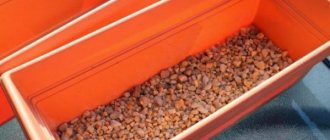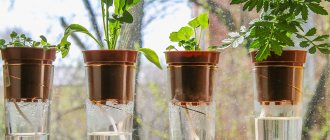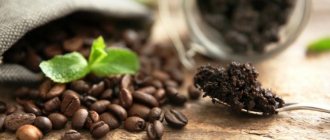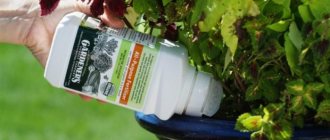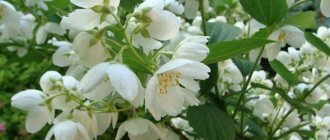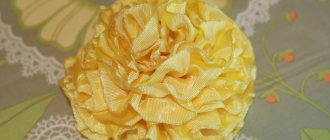- Aspirin or acetylsalicylic acid for fertilizing indoor plants - recipe.
- When to use aspirin for indoor plants?
- How is aspirin beneficial for plants?
- When to use hydrogen peroxide for indoor plants?
- How is hydrogen peroxide solution useful for indoor plants?
This article is especially for those who are afraid of organic fertilizers because of midges.
Aspirin for indoor flowers
Anyone can face the difficulties of growing houseplants. Even the most attentive and experienced flower growers have situations when their favorite flowers begin to look unhealthy or even die. The reasons may be different - this can happen either due to a banal oversight or regardless of the actions of the owner.
Fortunately, there are folk ways to save flowers from a stressful situation, even if the plants look really bad. To do this, you don’t need to look for gardening stores and buy some new serums or expensive fertilizers - simple improvised means that can be bought for a symbolic amount will help.
An example of an affordable alternative to expensive fertilizers is ordinary aspirin, which is sold in any pharmacy. This drug is acetylsalicylic acid, which is especially useful for plants as a fertilizer if the dosage and application rates are followed.
Important! You shouldn’t overdo it, or carelessly care for your plants, hoping that the drug will help indefinitely - the basis for guaranteeing healthy plants still remains regular and proper care.
Aspirin, or more precisely, its solution, is used both for emergency treatment of flowers with nutrients, and for prevention as a means of supporting their “immunity.” Aspirin is a universal fertilizer for the home garden, which is suitable for both fresh and cut flowers.
What are the benefits of aspirin for plants?
Many people know what effect aspirin has on humans - it is a primitive but effective analgesic. For flowers it plays a slightly different role.
This drug, or more precisely acetylsalicylic acid, is a serious source of substances beneficial to the flower. Naturally, acid has a positive effect on plant growth, helps it bloom magnificently and on time, protects it from many threat factors and generally activates growth - and therefore aesthetic qualities and reproduction potential.
The effect of aspirin solution on indoor flowers:
- Growth stimulation. Under normal and good conditions, the plant will stretch on its own, but there are “capricious” flowers or initially not very healthy specimens - you can even buy a flower with problems.
- More chances for successful reproduction. For all flowers, the use of aspirin has approximately the same effect in reproductive terms - the substance accelerates the work of all processes associated with the ovary and the formation of buds. If you need to propagate a flower faster or the plant does not bloom as planned, then feeding it with aspirin will help correct the situation and improve the quality of the seedlings.
- Preventive protection against pests and disease development. Acid adds substances to the plant, with the help of which it can cope with typical diseases more easily and quickly. Also, its high concentration is antifungal protection and repels most insects.
Thanks to fertilization with aspirin, the plant will bloom and delight with bright colors.
But the most important positive impact is emergency resuscitation. If the flower has not been properly cared for, is in poor condition and is obviously dying - its leaves fall, its stems wither, its petals fade and once green shoots turn yellow, then aspirin may be the only effective remedy that can revive the plant.
What else can you use?
Judging by the reviews, aspirin for indoor flowers can be a very effective helper. What to do if this drug is not available on the farm? Run to the pharmacy? Not at all necessary, let's try to find an alternative option:
- Sugar feeding. Almost any flower responds well to this procedure. Glucose in sufficiently large quantities is used by the plant for growth and development. At the same time, fertilizing is very simple: just sprinkle a spoonful of sand on the surface of the earth. When watering, the grains will melt and be absorbed into the soil.
- We use yeast. No, we won’t cook sweet pastries now, everything is much simpler. It is a source of natural B vitamins and other beneficial microelements. Plants need to be fed with yeast three times a year: in spring, summer and autumn. Just pour 10 g of live yeast into a liter of water and let it sit. This amount is enough to water one plant.
- Fertilizing with ammonia. This substance is a good fertilizer; plants easily absorb it. It perfectly helps with nitrogen deficiency and has a restorative and healing effect. Ammonia disinfects the soil, destroys fungi and various insect pests. It's quite easy to use. You just need to add a teaspoon of ammonia to a liter of water. Within a week the plants will turn green and begin to look much better.
When to use aspirin for houseplants
Acetylsalicylic acid is so useful for plants that it can be used on a regular basis, both in the warm season and in the cold. Care is especially important in winter, when plants stop growing intensively and one might say “hibernate.” During this period of time, they “want” as much attention as possible to themselves. Therefore, in order to preserve the healthy appearance of your home flowers for many years, it is recommended to make the use of aspirin not a forced measure, but a habit. For most plants, this procedure is sufficient to carry out twice a week.
Important! Aspirin can also significantly extend the life of gifted flowers in a vase - for this, instead of water, you should use its solution (2-3 aspirin tablets per liter of water). It has been proven that flowers in such an environment will be fresh and fragrant for a long time (up to a month). Even such whimsical flowers as roses can delight with their beauty for up to 10-14 days.
But if the plant has already reached a critical state or has suddenly entered the active phase of the disease, then to revive it it is necessary to act immediately - prepare a solution and immediately water the flower.
How to understand that a plant urgently needs help:
- leaves and stems became drooping;
- the “green” part of the plant has changed color to yellow - completely or partially;
- signs of parasite life appeared on the plant.
It is quite simple to identify a sick flower - it is immediately clear that without help and additional nutrition it will soon wither.
main reasons why apple tree leaves turn brown at the edges
The apple tree is the most popular fruit tree and at the same time the most delicate. It is very quickly exposed to various diseases, pests, and also reacts sharply to drought. One of the common problems...August 1, 2022, 10:10 ololo.tv–>
When the plant is stressed, such as by a pathogenic fungus, it produces small amounts of salicylic acid. It is this that protects the plant body from harmful microorganisms, drought and even insect attacks. Therefore, it is very useful to treat the plant with an aspirin solution to restore the balance of salicylic acid.
According to a recent USDA study, the use of aspirin significantly reduces the spread of fungal plant diseases.
Gardeners are recommended to spray aspirin tablets dissolved in distilled water (4 pieces per 4 liters) on plants. This drug is especially effective in combating diseases of plants of the nightshade family - especially potatoes and tomatoes. It is also helpful to dip plant seeds in the solution immediately before planting.
Photo source: ru.depositphotos.com
Don't forget about the norm!
You should be careful when using aspirin in the garden, as an overdose can burn or damage plants. Improper use may result in brown spots.
Correct dosage
Dissolve no more than one aspirin tablet in one liter of water. Also make sure it is completely dissolved. It is advisable to spray plants early in the morning, when they best absorb nutrients.
Methods of application
There are only two ways to use aspirin solution on home flowers - experienced gardeners use both watering and spraying. Thus, aspirin is a type of root and foliar feeding.
For both methods you will need an aspirin solution; the recipe is very simple (read the answer to how to prepare it below). In the first case, the solution is simply poured under the roots in the normal watering mode, in accordance with the needs of the plant. That is, as with regular watering, cactus and hydrangea will require different quantities and regularity. Be sure to remember that an excess of moisture in the soil is just as unfavorable for plants as a lack of it.
The second method requires a spray bottle (as a last resort, you can simply take the solution into your mouth and spray it - it is harmless). You can either spray the leaves, flowers and buds directly, or practice distant spraying to increase humidity.
Any of the methods will have a beneficial effect on the health, development and flowering of house plants.
How to water indoor flowers with aspirin
To treat flowers with aspirin, you don’t need to do anything special - just replace two waterings a week with an aspirin solution. It is not worth making changes to the volume, as well as to the method of watering. If the plant requires only one watering per week, you can alternate - water it as usual for a week, and with the solution the next week.
Important! An overdose of aspirin for plants is unlikely, but still you should not feed the medicine more often than recommended - you will not be able to get the best effect, and the concentration of any substance in excess can have a bad effect on the flowers.
The same applies to spraying. To ensure high-quality home care, the gardener is recommended to adhere to the treatment regime that is familiar to him. It is not recommended to completely replace water for spraying with aspirin solution. We must remember that for each situation and each plant you need to apply your own approach and care.
What to do if the plant dies:
- It is necessary to carefully examine the flower and try to determine what exactly is killing it. Perhaps the reason is quite dangerous, and the flower needs more serious help than aspirin.
- If pests are detected, it is better to give preference to chemical treatments that are aimed at destroying pests in all phases - larvae, adults, pupae. It is believed that aspirin will not help get rid of parasites if they are already active, but can be an excellent remedy for rehabilitation if the flower has already suffered from a pest-related disease.
- In all other cases, aspirin will serve as an excellent medicine. It is recommended to both water the soil of the plant (as much as possible, but within the limits of the flower’s moisture needs) and spray it outside.
- After treatment, it is advisable to carefully monitor the plant - the first results should appear soon. But sometimes it may take a little longer than usual. As an additional support, you can water the flower with aspirin solution a little more often until it returns to normal.
As a rule, using such a solution in the correct proportions and doses will guarantee a beautiful and healthy flower garden on the windowsill. But if it is clear that immediately after watering the plant’s condition began to deteriorate, then the treatment should be canceled immediately - perhaps this particular flower is an exception.
Preparation of the solution
The aspirin solution is prepared very simply and does not take much time; even a beginner can cope with this task. For preparation, the most common aspirin is suitable, which can be bought at a pharmacy at a very low price.
Step-by-step instruction:
- You can buy cheap domestically produced aspirin at any pharmacy. To avoid the imposition of expensive analogues, you can use online orders (there are many sites for ordering medications specifically).
- The basic proportion of the solution is to add a quarter of an aspirin tablet to 2 liters of water. You can divide the tablet into quarters using a regular knife.
- After a quarter of the tablet is separated, it is better to crush it into powder with a spoon - this will dissolve the drug faster.
- Dissolve aspirin in water. You can warm the water a little so that the aspirin dissolves faster. For the same purpose, it is necessary to dilute and stir the solution until no visible particles remain.
After preparation, it is advisable to leave the solution for half an hour and then return to it. If sediment has formed at the bottom, it should be stirred again.
How to revive roses if they're wilted
The best indoor bulbous flowers for home comfort
How to save roses from withering in a vase? There are quite a few effective recipes. A variety of means are used for this. However, first of all, you should provide the flowers with the most ordinary care.
How does flower resuscitation differ from simple care?
If you immediately put flowers in water, they can last a maximum of 5-7 days. Why do roses quickly wither in a vase? The reason is improper preparation of the bouquet. High-quality flowers can maintain their freshness for 3-4 weeks.
To prevent roses from fading, they need to be cut in the garden before they fully bloom. When purchasing, you should evaluate the appearance of the bouquet. The freshness of the flowers is indicated by the tight fit of the greenery under the buds. If the rose has already begun to fade, it has a drooping head and dried leaves.
So, to choose a high-quality bouquet, you need to focus on the following criteria:
The buds must be closed and strong enough. To be sure of the quality of the flowers, you can touch them. Fresh roses are quite dense. It is these specimens that can stand in a vase for as long as possible. The outer petals of the bud should not be open
It is important that they are strong enough. Such elements provide a kind of protection from the mechanical influence of external factors. Leaves should be as fresh and firm as possible
Wilted foliage can quickly turn black. The stems must be intact. If they are damaged, the flowers will not last long. This is due to a disruption in the supply of nutrients to the bud.
In winter, it is not recommended to immediately bring a bouquet from a cold street into a warm room. Exposure to sudden temperature fluctuations will negatively affect delicate buds. It is worth changing the temperature gradually.
Then it is recommended to remove the wrapping paper and other decorations from the bouquet. To saturate the flowers with moisture, it is recommended to keep them in water for 2 hours. It should be at room temperature.
Important! It is not recommended to immediately immerse roses in a bathtub or other bulk container - just put them in a bucket. If moisture gets on the petals, there is a high probability of rotting processes developing.
To preserve the freshness of the bouquet at home for as long as possible, it is worth treating the stems. Without this, the flowers will last a maximum of 7 days. To carry out the procedure, you need to cut the stem with a sharp knife. It is recommended to do this at an angle of 45 degrees. The procedure should be performed in water. If air penetrates the stem, the decomposition of the flower will occur much faster.
This trimming is primarily carried out to increase the area of contact of the cut with the liquid. In addition, performing this procedure helps to prevent the stem from burying itself in the bottom of the vase. If this happens, moisture will not be able to enter the flower tissue. In addition, it is permissible to carefully split the ends of the stem. Leaves and thorns below must be removed. This will help prevent the development of rotting processes.
To prevent roses from wilting, they need to be provided with optimal conditions. They are in many ways reminiscent of wintering indoor plants. In this case, experts advise adhering to the following recommendations:
It is forbidden to keep flowers under direct sunlight. Therefore, it is not recommended to place the bouquet on the windowsill.
This is especially true in spring and summer. There should be cool air in the room. The choice of vase is of no small importance. It is best to use an opaque glass pot or jug. It is important to avoid sudden fluctuations in temperature parameters and the influence of drafts. Some fruits and other flowers can have a negative effect on roses. Flowers do not respond well to the effects of cigarette smoke and exhaust fumes. You should not place flowers near heating sources.
It is recommended to change the water in the vase daily
It is important to wash the stems to prevent the accumulation of pathogenic bacteria. Cold showers are allowed for buds
In this case, moisture should fall exclusively on the outer petals.
In the summer, it is permissible to use rainwater for the bouquet.
It is important to ensure that the flower vase is as clean as possible. It should not contain remnants of other bouquets
At the same time, resuscitation of roses is not recommended to be confused with care, which is used to maintain the decorative appearance of the bouquet. Resuscitation measures are carried out to restore the attractive appearance of flowers.
Regularity of processing indoor flowers
Most flowers require treatment 1-2 times a week. But if the plant is initially watered non-standardly, then the feeding regime with aspirin will have to be adjusted to it.
Plants that need to be watered infrequently require less and healthy watering. But you shouldn’t be too diligent in calculating the amount of the substance that plants receive - acetylsalicylic acid is useful for them, and an overdose is unlikely.
Useful tips
Aspirin is not a new medicine; it has been used to help plants for quite a long time, so experienced gardeners have already established rules for using this drug, which only increase its effectiveness:
- If there are plans for the preventive use of aspirin solution, then it is better to start “accustoming” the flowers to this as early as possible.
- If the plant’s health is critical, do not be afraid to overdo it with aspirin - it is unlikely that the harm from too high a short-term concentration will be greater than the main danger to the flower.
- You should not prepare the solution in advance - like any other substance, aspirin erodes and loses its properties. It is best to water flowers with freshly prepared medicine. To prepare, you can simply divide the purchased tablets into quarters (remember, dissolve 1/4 of an aspirin tablet in 2 liters of water).
When caring for flowers and indoor plants, it is great to have an inexpensive and accessible product on hand, the search for which will not take much time from gardeners. Of course, aspirin is not a panacea for all plants, it will not increase the yield in the garden, but weekly feeding of home flowers with it will certainly improve their condition. Aspirin is just such a multifunctional drug used in emergency situations, which does not require careful measurements, special skills and abilities, and does not pose a danger to humans and pets.
On the site you will learn secrets that will help you grow and maintain beautiful indoor plants in your home. The articles contain useful information on how to care for plants so that they bloom abundantly in the spring; how to prepare for wintering in October - November and much more. And in the comments you can share your own experience of caring for indoor plants.
How to buy a rose that can stay fresh for a long time
The length of time it stays in the vase depends on what kind of flower you buy; freshness is what you should pay attention to when purchasing. In order to accurately choose a freshly brought flower in a store, you need to know the following rules that real professionals use:
- When choosing roses in a bouquet that was not picked before your eyes, you can end up with a flower that is not the freshest.
- Many people prefer buds that have just begun to bloom, but this is wrong. At home, this option will not open at all, the reason for this is the immaturity of the plant. A bouquet of roses in a vase will last a long time if each component is half-opened.
- Feeling the bud at the base will help determine freshness; it should be dense and elastic there.
- The leaves will also tell about the freshness of the flower; they should be juicy and rich in color.
- Inspection of the stem will also help in choosing; along its entire length it should be dense, green, without color differences.


